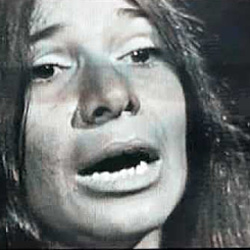
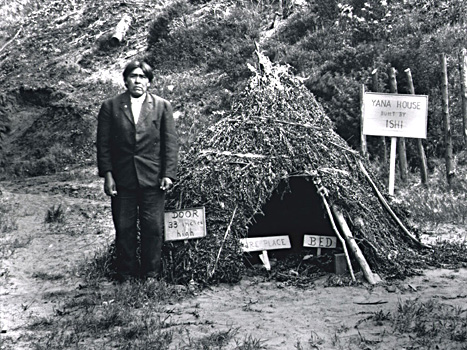
Ishi died 100 years ago, March 25, 1916–anthropology’s man of two worlds, the last stone age man, the last wild man, museum specimen, and closest friend. Raised on the Ishi story, we commemorate this sad centennial with reflections on his friendships cut-short, his camping experience, his influence on modern archery, and beyond to his architectural influence and its own untimely end.
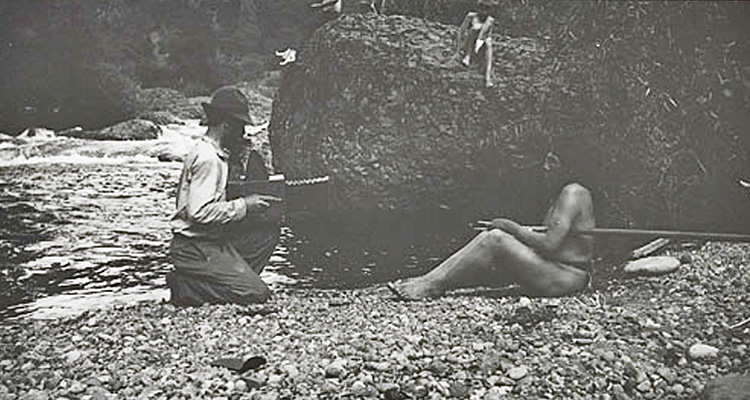
Above, Ishi is photographed by friend and anthropologist, Alfred Kroeber, considered the father of California Indian Studies and Dean of American Anthropology. Behind Ishi frolics the 11 year old Saxton Pope, Jr., Ishi’s swim mate, bunkmate, and young confidant. Within 2 years of the camp-out photo shoot and 5 years of joining Western Culture, Ishi succumbs to tuberculosis. Within 16 years, the boy Saxton Pope, Jr., would have his first of three residences designed by California Architect William Wurster (see our post: Better Wurster?).
BRIEF BIOGRAPHY
Professor Kroeber’s second wife Theodora immortalized Ishi in several books including her Ishi in Two Worlds: A Biography of the Last Wild Indian in North America (1961), presenting the sixties and seventies with a classic texts for the study of anthropology. Ishi, after 50 years in hiding and uncertain years alone, having his tribe massacred, his home ransacked and his family (elder parents and sister) driven apart and lost, is discovered frightened and hiding in a slaughter house near Oroville, himself lost in spirit. Within two days he’s taken by the linguist T.T. Waterman and anthropologist Alfred Kroeber to the UC Museum of Anthropology, at the present location of UCSF, Parnassus Street in San Francisco, where he becomes a centerpiece of study–linguistic, biological, and cultural, a museum curiosity, a society darling and sometimes a newspaper punchline. He appears to maintains his self esteem, and clearly gains some fondness for modern culture and his new modern friends. The fondness is deep and mutual if unavoidably compromised by a cultural gap, social roles and the personal and modern ambitions of his new friends.
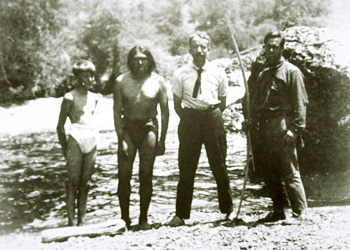
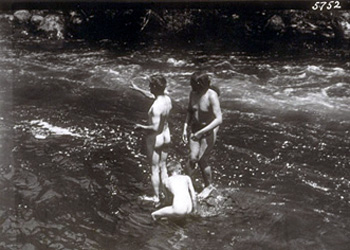
For 19 days in May of 1914, Ishi and his brilliant and accomplished buddies, his anthropologist, his linguist, his doctor and doctor’s boy, backpack Ishi’s abandoned family home and hiding spots in the wilderness brush around Deer and Mill Creek. Theodora labels this chapter of Ishi’s life “The Brightest Year”. Certainly as well documented as Ishi’s Yahi culture, is this early 20th century bromance of Ishi and these Bay Area outdoorsy academics. With Kroeber holding the camera for these family photos, pictured are Saxton Pope, Jr., Ishi, the linguist T.T. Waterman and with long bow Dr. Saxton Pope, Sr., Ishi’s doctor, later revered as the Father of Modern Archery. Numerous photos of Ishi swimming include this with the Popes, Dr. and Jr. Camping with an anthropologist and camera-nut, a linguist, a surgeon and archery-nut, a 11 year-old boy and “the last wild man” — what an incredible group for a male-bonding trip into pre-history and inevitably, into human relations. This piece from the Wit and Wisdom of Saxton Pope gives an idea of the intensity campfire conversation.
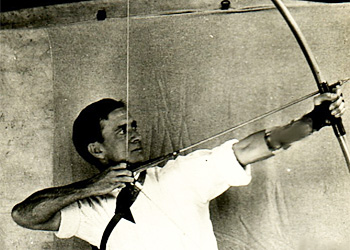 I must admit that there are quite a number of things men do that mark them as far below the angels, but in a way I am glad of it. The thrill and glow of nature is strong within us. The great primitive outer world is still unconquered, and there are impulses within the breast of man not yet measured, curbed and devitalized, which are the essential motives of life. Therefore, without wantonness, and without cruelty, we shall hunt as long as the arm has strength, the eye glistens, and the heart throbs.
I must admit that there are quite a number of things men do that mark them as far below the angels, but in a way I am glad of it. The thrill and glow of nature is strong within us. The great primitive outer world is still unconquered, and there are impulses within the breast of man not yet measured, curbed and devitalized, which are the essential motives of life. Therefore, without wantonness, and without cruelty, we shall hunt as long as the arm has strength, the eye glistens, and the heart throbs.
T.T. Waterman presents this gentler reminisce of the back pack in his 1918 The Yana Indians:
On the whole he took very kindly to civilization. He seemed apprehensive at times that we would send him back ultimately to his wilderness. Once when we were planning with much enthusiasm to take him on a camping trip, to revisit with him his foothill home, he filed a number of objections. One was that in the hills there were no chairs. A second was, that there were no houses or beds. A third was, that there was very little to eat. He had been cold and gone empty so often, in the hills, that he had few illusions left. In camp, however, he proved to be a fine companion. He could swim and wash dishes and skylark with anybody, and outwalk everybody.
He convinced me that there is such a thing as a gentlemanliness which lies outside of all training, and is an expression purely of an inward spirit. It has nothing to do with artificially acquired tricks of behavior. Ishi was slow to acquire the tricks of social contact. He never learned to shake hands but he had an innate regard for the other fellow’s existence, and an inborn considerateness, that surpassed in fineness most of the civilized breeding with which I am familiar. His life came to a close as the result of an over susceptibility to tuberculosis, to which he was at some time or other exposed, and to which he never developed the slightest immunity. He contributed to science the best account he could give of the life of his people, as it was before the whites came in. To know him was a rare personal privilege, not merely an ethnological privilege. I feel myself that in many ways he was perhaps the most remarkable personality of his century.
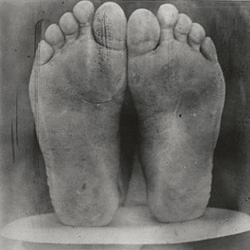 Thanks largely to Ishi’s friends, there is a generous amount of documentation of Ishi, his culture, his language, his outdoor skills and physical body. Left, the plaster cast of Ishi’s feet from hospital records. Pope considered the feet “a beautiful example of what the human foot should be”.
Thanks largely to Ishi’s friends, there is a generous amount of documentation of Ishi, his culture, his language, his outdoor skills and physical body. Left, the plaster cast of Ishi’s feet from hospital records. Pope considered the feet “a beautiful example of what the human foot should be”.
The friendships are intense, but brief. He is hospitalized several times as carefully chronicled by Dr. Pope and the UC Medical School. Once for respiratory illness, broncho-pneumonia, abdominal pain, back pain and twice for tuberculosis. He finally dies within 5 years of his slaughterhouse discovery. Pope is involved in authorizing his autopsy and the dissection of his brain against Kroeber’s wishes and his promise to Ishi, whose dissected brain is shipped to the Library of Congress. As Edward Gifford museum curator wrote at the time, they were truly attempting a ‘compromise between science and sentiment,’ With Ishi’s death and suffering also from a not yet diagnosed case of Meniere’ disease and the recent death of his first wife, the distraught Kroeber writes of fears of insanity. He turns to Freudian analysis for himself, and considers leaving the field of anthropology altogether.
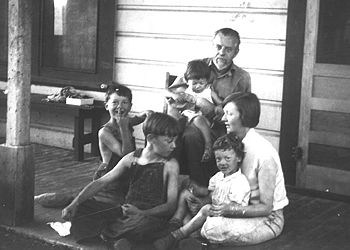 After Kroeber’s death, Ishi’s life story became a cottage industry for Kroeber’s second wife and family pictured in 1931 from left to right: Theodore, Clifton, future sci-fi writer Ursula Le Guin, Karl, Theodora and Alfred at top. In 2002 her children Karl and Clifton edit Ishi in Three Centuries, from a variety of author’s essays recasting the story and the blame . Included are more recent thoughts on the repatriation of Ishi’s ashes from a Colma cemetery and his brain from the Library of Congress for burial in his tribal homeland by American Indians of another tribe still extant.
After Kroeber’s death, Ishi’s life story became a cottage industry for Kroeber’s second wife and family pictured in 1931 from left to right: Theodore, Clifton, future sci-fi writer Ursula Le Guin, Karl, Theodora and Alfred at top. In 2002 her children Karl and Clifton edit Ishi in Three Centuries, from a variety of author’s essays recasting the story and the blame . Included are more recent thoughts on the repatriation of Ishi’s ashes from a Colma cemetery and his brain from the Library of Congress for burial in his tribal homeland by American Indians of another tribe still extant.
It is difficult not to read the biographies, the ethnographic studies and historical fictions as parable of the tragic challenges of anthropology as science and of cultural chasms. It becomes evident that Ishi’s two worlds are not simply the aboriginal and Western culture, but (1) his real world of the life lived and (2) the painfully symbolic narrative of Native American cultural annihilation.
 With lengthy descriptions of Ishi’s hunting techniques, Dr. Saxton Pope’s own classic Hunting with Bow and Arrow (1923) moves well beyond sports technique and science to a touching description of a close friendship and a romance with a more primitive culture and a wilder nature.
With lengthy descriptions of Ishi’s hunting techniques, Dr. Saxton Pope’s own classic Hunting with Bow and Arrow (1923) moves well beyond sports technique and science to a touching description of a close friendship and a romance with a more primitive culture and a wilder nature.
Hunting with Ishi was pure joy. Bow in hand, he seemed to be transformed into a being light as air and as silent as falling snow. … I was struck from the first by his noiseless step, his slow movements, his use of cover. … Time meant nothing to him; he simply stayed until he got his game. He would watch a squirrel hole for an hour if necessary, but he always got the squirrel.
He made great use of the game call. We all know of duck and turkey calls, but when he told me that he lured rabbits, tree squirrels, wildcats, coyote, and bear to him, I thought he was romancing. Going along the trail, he would stop and say, “Ineja teway—bjum—metchi bi wi,” or “This is good rabbit ground.” Then crouching behind a suitable bush as a blind, he would place the fingers of his right hand against his lips and, going through the act of kissing, he produced a plaintive squeak similar to that given by a rabbit caught by a hawk or in mortal distress. This he repeated with heartrending appeals until suddenly one or two or sometimes three rabbits appeared in the opening. They came from distances of a hundred yards or more, hopped forward, stopped and listened, hopped again, listened, and ultimately came within ten or fifteen yards while Ishi dragged out his squeak in a most pathetic manner. Then he would shoot.”
SNAPSHOTS: KROEBER, SAXTON POPE, WURSTER AND THE RAMADA
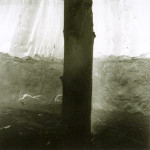 Thanks to Alfred Kroeber’s work the On-line Berkeley archives and Calisphere contain amazing archaeological and architectural photo documentation like Ishi’s own deer skin quiver, shown above, as well as the intimate family camp-out photos at top. Of interest to the architect are the photos of California Native American dwellings, many taken by Kroeber at the beginning of the 20th century, among them this stunning study of light and shadow within a smoke lodge interior of thatch and gravel. Included in his Handbook of the Indians of California (1925), Kroeber’s own photos from 1907 show a Cahuilla house in the desert near Indio. A ramada surrounds the dwelling with the thatched windbreak and sunshade continuous and integral with the dwelling walls and roof themselves.
Thanks to Alfred Kroeber’s work the On-line Berkeley archives and Calisphere contain amazing archaeological and architectural photo documentation like Ishi’s own deer skin quiver, shown above, as well as the intimate family camp-out photos at top. Of interest to the architect are the photos of California Native American dwellings, many taken by Kroeber at the beginning of the 20th century, among them this stunning study of light and shadow within a smoke lodge interior of thatch and gravel. Included in his Handbook of the Indians of California (1925), Kroeber’s own photos from 1907 show a Cahuilla house in the desert near Indio. A ramada surrounds the dwelling with the thatched windbreak and sunshade continuous and integral with the dwelling walls and roof themselves.
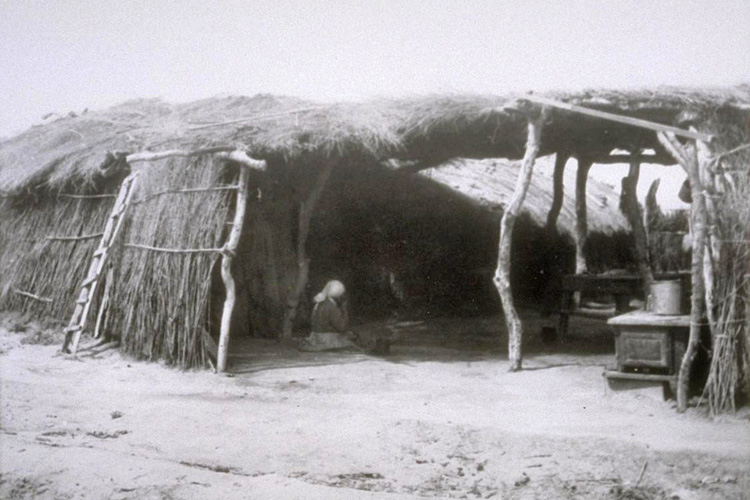
Kroeber points to the descriptions of Barrows Ethnobotany of Southern California Indians:
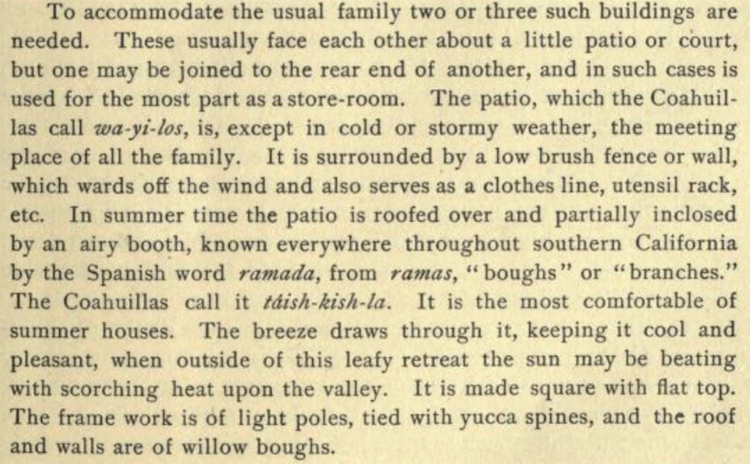
Photos and stories of the Ishi camping trip documents the connection between the Kroeber family and the Pope family. A direct connection between Saxton Pope, Jr.’s Orinda home design below and Kroeber’s photos of Native American dwellings is conjecture, but Barrows description points out comparisons evident between photos of the primitive dwelling and the one-of-a kind Wurster dwelling.

Wurster’s built his career on homes and summer homes styled on the camp and farmhouse dwellings of early California settlers, grouping rooms around courtyards and orienting openings and protection to weather patterns, sun direction and views. The connections to place and history are as basic to his work as function and simplicity. The attached fence forming a courtyard or compound was common in his early work in the hills around Sacramento and Santa Cruz including the Gregory Farmhouse and dwellings at Pasatiempo in the thirties. Their is a record of the intense correspondence between Wurster and Pope during design and after. In one of many letters to Wurster, Saxton Pope complained of the unwanted attention, with the home regularly attracting uninvited guests regularly invading their hidden garden retreat.

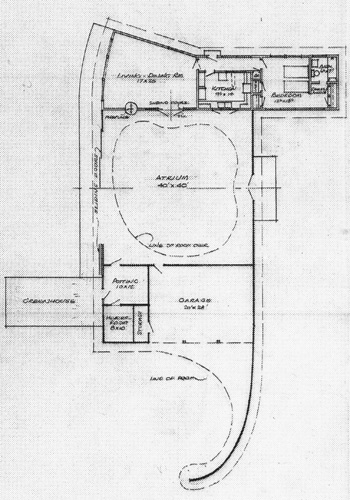
The seahorse like plan shown here was pre-liminary to the final orthogonal plan, but gives an idea of the dispositions of parts. The functional toughness of the materials– the gravel patio, the corrugated metal for the patio enclosure and the concrete C-block for the exterior and interior walls of the living spaces–complement the simple abstraction of the plan with its layout of circular opening and square patio, and of the unadorned wall planes and sliding panels defining the spaces of an open plan instead of rooms and doors.
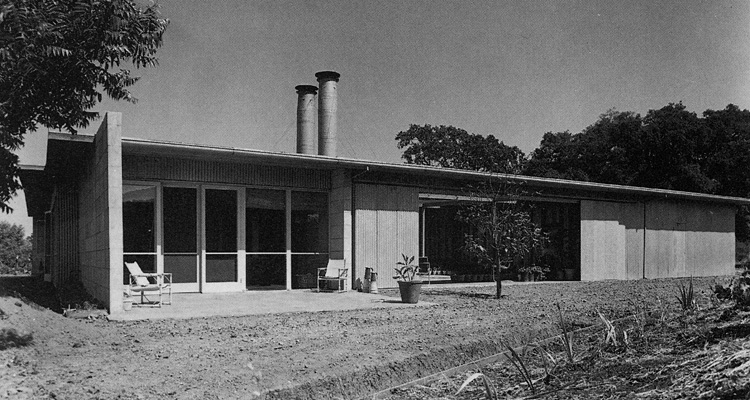
Marc Treib in his Everyday Modernism: the Homes of William Wurster wrote “one senses the house could almost be cleaned with a hose.” Unfortunately, the house was not so durable and was demolished in 1964, within 14 years of construction, making way for a freeway cloverleaf–a tragic loss for Wurster, the Popes and the uninvited architectural tourist.
By comparison, Barrows cites the wonderful functionalism of the Cahuilla huts of brush and mud called jacals:
The admirable features of the jacal [hut] can be instantly appreciated. It is easily kept clean and is always well aired. Its only drawback is that it is smoky, especially in wet weather. The rafters and thatching are black and shiny from the soot of many fires. Not the least of its hygienic features is the fact that being easily built, it does not outlast its freshness. As soon as dilapidation appears and the dirt collects, down it comes and a new one takes it place on a fresh site a few yards away. It is seldom that all the houses of a family are left the same for two successive years.
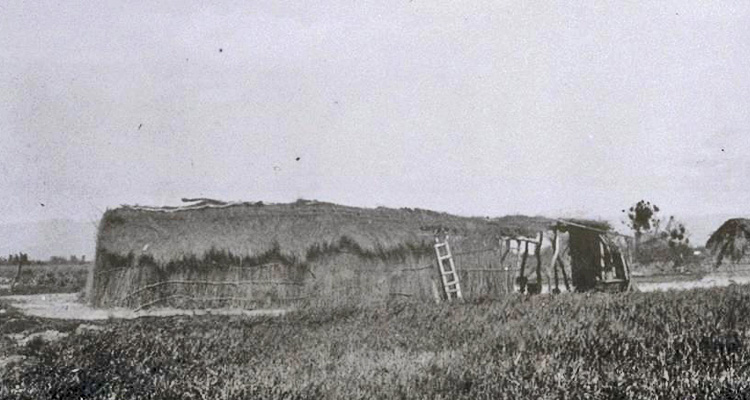
Thanks to Roger Sturtevant for his architectural photograph of the Pope Residence, and, of course, to Alfred Kroeber and his inspired photo work. For more on Ishi check out the poetically filmed teleplay of TheodoraKroeber’s poetic historical fiction Ishi, Last of his Tribe from 1978 with Dennis Weaver as the linguist and scripted by Dalton Trumbo’s son, Christopher. For an alternative view to Ishi’s get-along-attitude towards civilization than the historical record portrays, check out Buffy Sainte-Marie’s bitter and shattering hymn.
